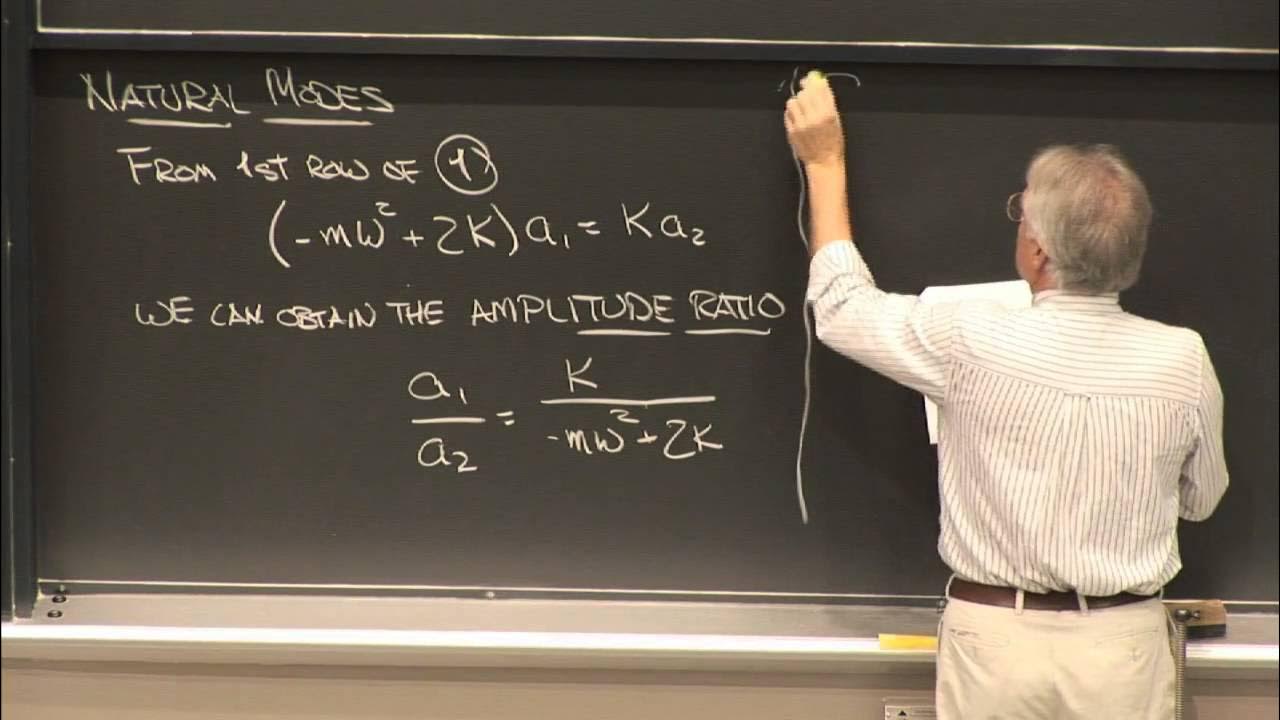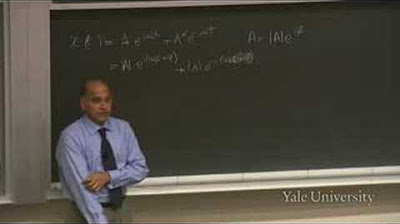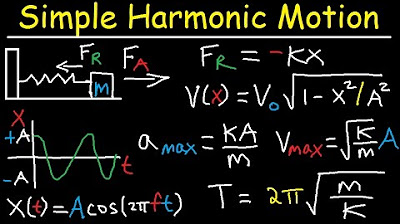19. Introduction to Mechanical Vibration
TLDRThe MIT lecture introduces the concept of vibration in applied dynamics, emphasizing its relevance in everyday life, from speech to musical instruments. It focuses on single degree of freedom systems, explaining how to model and analyze their behavior using Mass-Spring-Dashpot systems. The lecture explores natural frequencies, the impact of pre-compression on these frequencies, and solving equations of motion. It also delves into the effects of damping on vibration, introducing the damping ratio and its significance in determining system behavior, from critical damping to under-damped conditions. Practical examples and the logarithmic decrement for estimating damping ratios are discussed, providing students with tools to understand and analyze real-world vibration scenarios.
Takeaways
- 📚 Today's lecture focuses on establishing vocabulary around vibration, which is applied dynamics.
- 🔍 Vibration is a common phenomenon and can be both desirable (e.g., music) and undesirable (e.g., noise).
- 🛠 The term will focus on the resulting motion of systems and solving equations of motion.
- 🧪 Understanding single degree of freedom systems is crucial, as they help model more complex systems.
- 🔧 Vibration can be modeled using a Mass-Spring-Dashpot system to understand its behavior.
- 🎼 Vibration has natural frequencies and modes, which are essential for understanding system behavior.
- 📊 The natural frequency of a system is determined by its stiffness and mass, and is not affected by pre-compression forces.
- ⚖️ The static equilibrium position is crucial for simplifying and solving the equations of motion.
- 🕰 Solving differential equations for vibration involves initial conditions like displacement and velocity.
- 🔄 Damped systems have a damped natural frequency, slightly different from the undamped frequency, and damping affects the system's behavior over time.
Q & A
What is the main focus of the lecture?
-The main focus of the lecture is on vibration, which is essentially applied dynamics, and the establishment of vocabulary related to single degree of freedom systems.
Why is vibration an important topic to study?
-Vibration is an important topic because it is a common phenomenon with both positive and negative aspects. It is essential for speech and musical instruments but can also be undesirable, such as when causing disturbances like rattling from an air conditioner.
What is a single degree of freedom system?
-A single degree of freedom system is a system that can move in only one direction or mode. Examples include a simple pendulum or a mass-spring-dashpot system, which can be used to model more complex systems by isolating one particular mode of vibration.
Why is it beneficial to understand the behavior of a Mass-Spring-Dashpot system?
-Understanding the behavior of a Mass-Spring-Dashpot system is crucial because it provides the fundamental vocabulary and concepts used to analyze and deal with more complicated vibration problems.
How does pre-compression in springs affect the natural frequency of a system?
-Pre-compression in springs does not affect the natural frequency of a system. The natural frequency is determined by the stiffness and mass of the system, and external forces that are not functions of the motion variable do not influence it.
What is the equation of motion for a non-homogeneous system with two springs and a mass?
-The equation of motion for such a system is mx'' + (k1 + k2)x = (L/2)(k1 - k2), where m is the mass, x is the displacement, k1 and k2 are the spring constants, and L is the original length of the springs when they meet in the middle without the mass.
What is the significance of the natural frequency in the context of this lecture?
-The natural frequency is significant as it describes the inherent oscillation frequency of a system without external influences. It is a key parameter in understanding how a system will respond to initial conditions or external excitations.
How can the response of a system to initial conditions be described mathematically?
-The response of a system to initial conditions can be described mathematically as x(t) = A1 cos(ωnt) + B1 sin(ωnt), where A1 and B1 depend on the initial conditions, ωn is the natural frequency, and t is time.
What is the difference between the undamped natural frequency and the damped natural frequency?
-The undamped natural frequency (ωn) is the frequency at which a system oscillates without any damping. The damped natural frequency (ωd) is slightly less than ωn and accounts for the reduction in oscillation frequency due to damping in the system.
What is the damping ratio and why is it important?
-The damping ratio (zeta) is a dimensionless number that indicates the amount of damping in a system compared to the critical damping. It is important because it determines the type of motion the system will exhibit in response to external forces or initial conditions, such as oscillation with decay or exponential decay without oscillation.
How can the damping ratio be experimentally determined?
-The damping ratio can be experimentally determined using the logarithmic decrement, which is the natural logarithm of the ratio of the amplitude of two successive peaks of the system's response, divided by the number of periods between them.
What is the relationship between the logarithmic decrement and the damping ratio?
-The damping ratio (zeta) can be calculated from the logarithmic decrement using the formula zeta = 1 / (2πn) * ln(Amplitude at time t / Amplitude at time t + nTd), where n is the number of cycles, and Td is the damped period of vibration.
Why does the frequency of a vibrating system change when damping is introduced?
-The frequency of a vibrating system changes when damping is introduced due to the added mass effect, where the system appears to have a larger mass because of the surrounding medium (like water) that moves with it, not because of the damping itself, which only causes a small change in frequency.
Outlines
📚 Introduction to Vibration and Dynamics
The lecture begins with an introduction to the importance of studying vibrations, which are fundamental to various phenomena such as speech and music. The instructor emphasizes that while finding equations of motion has been the focus so far, the rest of the term will concentrate on the resulting motion, particularly on how to analyze and control vibrations. The concept of a single degree of freedom system is introduced as a basic building block for understanding more complex vibrational phenomena, with examples provided to illustrate the point.
🔍 Exploring Single Degree of Freedom Systems
This section delves into the specifics of single degree of freedom systems, using a Mass-Spring-Dashpot model with two springs as an example. The instructor guides the audience through the process of creating a free body diagram and deriving the equation of motion for the system, taking into account pre-compression in the springs. The natural frequency of the system is discussed, and the audience is encouraged to predict whether pre-compression affects it. The equation of motion is then rearranged to highlight the importance of understanding the behavior of such systems.
📉 Understanding Natural Frequency and External Forces
The instructor clarifies the concept of natural frequency and its independence from external forces that do not depend on motion coordinates. Using the example of a mass-spring system with pre-compression and a hanging mass system, it is shown that the natural frequency is determined by the stiffness and mass of the system, not by external forces like gravity. The equation of motion for the non-homogeneous system is presented, and the process of finding the static equilibrium position is discussed.
🧩 Analyzing the Equation of Motion and Static Equilibrium
The paragraph focuses on solving the differential equation of motion for a system with a constant term, which represents a non-homogeneous scenario. The static equilibrium position is calculated, and the concept of separating the motion variable into static and dynamic components is introduced. This approach simplifies the equation of motion and allows for a clearer understanding of the system's natural frequency and behavior.
🌀 The Role of Initial Conditions in Vibration
The discussion turns to the role of initial conditions in the motion of a system without external excitation. The solution to the equation of motion is presented in the form of a cosine function, highlighting that any motion is a result of initial displacement or velocity. The natural frequency of the system is derived from the equation, and the solution is expressed in terms of initial conditions, showing how the system responds to them.
🔧 Damping and Its Effect on Vibration
Damping is introduced as a factor that can complicate the vibration of a system. The paragraph explains how damping affects the equation of motion and the resulting motion. The solution to the damped system is explored, showing that the motion can be expressed in terms of cosine and sine functions, with the amplitude decaying over time. The importance of understanding the phase angle and its relation to initial conditions is emphasized.
📐 Phase Angle and Its Significance in Vibration Analysis
The concept of phase angle is explored in depth, explaining its meaning and relevance in the context of vibration analysis. The instructor uses a graphical representation to illustrate how the phase angle relates to the initial conditions and the time delay to reach the peak of the vibration. The relationship between the phase angle and the time delay is quantified, providing a clear understanding of how these concepts are used in analyzing system behavior.
🎓 Reviewing Vibration Concepts from a Engineering Perspective
The lecture revisits concepts from a previous course, 1.803, but this time from an engineer's perspective. The focus is on the homogeneous equation of motion with damping and the use of the quadratic equation to find the system's response to initial conditions. The engineer's approach to solving the quadratic equation is presented, introducing terminology such as the damping ratio and the critical damping concept.
🔄 The Impact of Damping on System Response
This section discusses the impact of damping on the system's response to initial conditions. The solutions for different cases of damping (zeta less than 1, equal to 1, and greater than 1) are presented, highlighting the differences in system behavior. The importance of the damping ratio in determining whether the system will oscillate or not is emphasized, and the solutions for each case are analyzed.
📉 Damped Oscillation and Its Characteristics
The paragraph focuses on the characteristics of damped oscillation, particularly when the damping ratio is less than 1. The solution to the equation of motion for this case is detailed, showing how the system's motion is a combination of exponential decay and oscillation. The concept of the damped natural frequency is introduced, and the solution is expressed in terms of initial conditions, illustrating how the system's response changes over time.
🌊 The Myth of Damping and Frequency Change
The instructor dispels the common myth that damping is the primary cause of frequency change in a vibrating system. Using the example of a pendulum in water, it is explained that the observed change in frequency is not due to damping but rather to added mass, which affects the system's kinetic energy. The importance of distinguishing between the effects of damping and other factors on frequency is highlighted.
⏱️ Estimating Damping Ratio Using Logarithmic Decrement
The lecture concludes with a practical method for estimating the damping ratio of a system using the logarithmic decrement. The process involves measuring the response of the system over time and calculating the ratio of two peak values separated by a certain number of periods. The formula for estimating the damping ratio is provided, along with a rule of thumb for quick estimation based on a 50% decay in amplitude.
🔚 Summary of Vibration Concepts and Application
In the final paragraph, the instructor summarizes the key concepts discussed in the lecture, emphasizing their importance for understanding more complex vibrations in future lessons. The practical application of these concepts is highlighted, and students are reminded of their relevance to real-world scenarios. The lecture ends with well-wishes for an upcoming quiz and a reminder of the next class meeting.
Mindmap
Keywords
💡Vibration
💡Applied Dynamics
💡Equations of Motion
💡Single Degree of Freedom Systems
💡Natural Frequency
💡Mass-Spring-Dashpot
💡Pre-compression
💡Static Equilibrium Position
💡Damping
💡Damping Ratio
💡Logarithmic Decrement
Highlights
Introduction to the importance of establishing vocabulary in vibration studies within the context of applied dynamics.
Explanation of why vibration is a crucial topic, with both positive and negative impacts on daily life.
The concept of modeling continuous systems with an infinite number of degrees of freedom using single degree of freedom systems.
Discussion on the natural frequency and mode shapes of vibrating systems, such as an aluminum rod.
Demonstration of how to model a natural mode with its single degree of freedom equivalent using a Mass-Spring-Dashpot system.
Introduction of a Mass-Spring-Dashpot system with two springs to illustrate the effect of pre-compression on natural frequency.
The revelation that external forces not related to motion coordinates do not affect the natural frequency of a system.
Explanation of how to derive the equation of motion for a system with non-zero force in the spring, using a free body diagram.
Development of the concept of static equilibrium position and its significance in solving differential equations.
Introduction of the method to rewrite equations of motion around the static equilibrium position for easier analysis.
Differentiation between translational and rotational single degree of freedom systems and their common differential equation form.
Solution of the equation of motion for a damped system and the introduction of terminology such as natural frequency and damping.
Explanation of how initial conditions are the only source of motion for a system without external excitation.
Derivation of the formula for the response of a system to initial conditions, highlighting the role of amplitude and phase angle.
Introduction of the concept of phase angle and its significance in understanding the delay in reaching the peak of vibration.
Discussion on the impact of damping on the natural frequency and the importance of distinguishing between undamped and damped frequencies.
Presentation of the logarithmic decrement method as a practical way to estimate the damping ratio of a system.
Rule of thumb for quickly estimating damping ratio when the amplitude has decayed to half of its initial value.
Final remarks on the importance of understanding damping and natural frequency for analyzing and controlling vibrations.
Transcripts
Browse More Related Video

Understanding Vibration and Resonance

22. Finding Natural Frequencies & Mode Shapes of a 2 DOF System

24. Modal Analysis: Orthogonality, Mass Stiffness, Damping Matrix

1. Periodic Oscillations, Harmonic Oscillators

17. Simple Harmonic Motion

Simple Harmonic Motion, Mass Spring System - Amplitude, Frequency, Velocity - Physics Problems
5.0 / 5 (0 votes)
Thanks for rating: